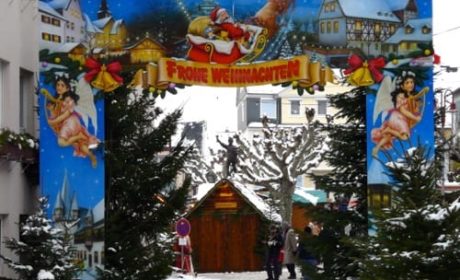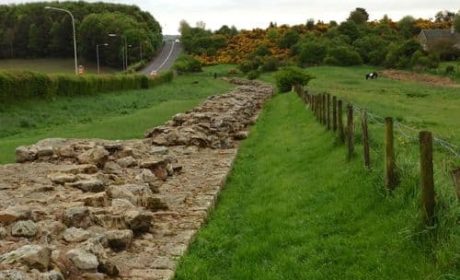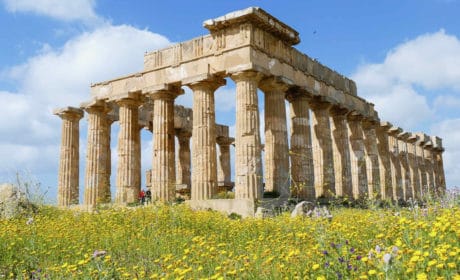Want to go off-the-beaten-path in Italy? Visit the Tremiti Islands off Italy’s Gargano Peninsula. Okay, I’m sure that most Italians and Western Europeans know about these tiny islands near the Adriatic coast.
But how many Americans visit? Alan and I are raising our hands, here, and giving you reasons to add them to your next European road trip.
How to visit the Tremiti Islands

Most visitors arrive at Italy’s Tremiti Islands by ferry or hydrofoil. In the summer, ferries run frequently from several port cities along the Italian Adriatic coast.
On our October visit, the ferry schedule was infrequent, leaving from cities that were inconvenient from our accommodations at Edificio 15 House Elite in Rodi Garganico. That’s why guide, Claudio Fontana of A La Carte Italy Tours, suggested that we arrive by commuter helicopter. Actually, it was a big part of the fun.

From a heliport in Viesti, Alan, Claudio and I hurried out to the helicopter operated by Alidaunia. Winds from the helicopter’s rotor blades blew hair, hats and anything else not firmly held down. Joining about 10 other passengers who had been picked up in Foggia, we looked down on buildings, soccer fields and roads as the helicopter lifted and the Gargano coast slowly slipped away.
Sunlight danced off the choppy Adriatic when the helicopter approached the archipelago of five islands—San Nicola, San Domino, Capraia, Cretaccio and Pianosa. They looked like small, craggy rocks jutting up from the sea.
After landing on Capraia to let off two scientists at a research station, the ride continued to San Domino, one of the only two inhabited islands. San Nicola, home to the abbey-fortress complex of Santa Maria a Mare, being the other one.
What to see in the Tremiti Islands

In summer, the clear waters surrounding the Tremiti Islands attract divers and snorkelers. Part of Gargano National Park, the Riserva Marina Naturale Isole Tremiti offers abundant marine life including lobster, octopus and moray eel.
You’ll also see unique geological formations just below the water’s surface. Wrecks from as far back as ancient Rome tempt the more advanced scuba diver.
But we were visiting the Tremiti Islands to explore its history located on the land rather than the shipwrecks resting on the bottom of the sea.
After the helicopter landed, Alan, Claudio and I strolled toward San Domino’s port along a path edged with juniper and shaded by pine trees. We stopped at a coffee bar for the requisite cappuccino, which also meant that we could use the facilities.
Taking the tour boat to Grotta del Bue Marino

At the small port, Claudio negotiated with a tour boat owner for us to join a tour that was just leaving. The boat tour circumnavigated San Domino to show guests the many sea caves located around the island. At Grotta del Bue Marino, the boat slipped inside to give us a closer view.
The tour stopped at San Nicola, a short ride across the small channel that divides the two islands. We would have several hours of exploring before the boat picked us up again later in the afternoon.
The steep steps leading up the limestone cliff to the populated portion of San Nicola were deep and wide. It was like walking into history when we passed through the huge wooden door—the only entrance onto the island. At the top were fortifications where monks of the Middle Ages, who populated the island starting around the ninth century, defended themselves from pirates and usurpers.
Exploring Tremiti Island history

But the monks weren’t the island’s first residents. Archaeologists believe the Tremiti Islands have been inhabited since the Iron Age (4th to 3rd centuries BC).
Legend says that Diomedes, the courageous hero of the Iliad created the islands, once known as Diomede Islands. A tomb from the Hellenic era, known as the Tomb of Diodmede, is located on grounds behind the monastery.
San Nicola has been used as a prison since ancient times. Roman emperor Augustus exiled his granddaughter, Julia the Younger, to San Nicola. Her crime? Having an affair with a Roman senator.
In 1793, King Ferdinand IV of Naples ended the monks’ profitable reign turning San Nicola into a penal colony once again. Later, in 1843, King Ferdinand II of Two Sicilies repopulated the island with people from Naples’ slums.
Perhaps that’s one reason that the approximately 350 full-time residents are rumored to be descendants of Napoli mobsters. San Nicola continued as a penal colony during Benito Mussolini’s fascist regime, when he rounded up homosexual men and imprisoned them on the island.
A visit to San Nicola is for strolling, wandering and wondering. We stepped into the church of Santa Maria a Mare to see the mosaic floors and intricate ceilings. Continuing our walk on the grounds, monastery ruins and watchtowers beckoned to be explored. And, always, there was the sea—to watch, to photograph, to imagine.

Our visit to San Nicola ended with a lunch on the patio of a restaurant near the small beach where the tour boats offloads visitors. Mussels, white wine and Tremiti Island history made a delicious combination.
More to see along Italy’s Adriatic coast
Italy’s eastern coast doesn’t get as much attention as the ports cities on the Mediterranean. If you enjoy off-the-beaten destinations, a drive down the Adriatic coast of Italy will provide it. Along the way, stop to explore:
- A trip to Trani is filled with an intriguing Jewish Quarter, beautiful church and delicious food.
- Or continue to the boot of Italy’s heel to explore Otranto.
Want to plan your own trip to Italy? Start at the My Itchy Travel Feet Italy Travel Planner page.



